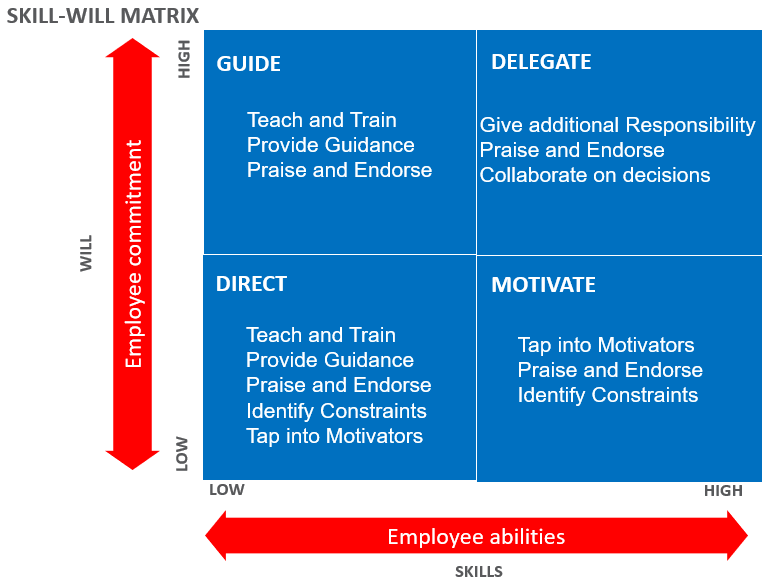
One of the most powerful frameworks I’ve been exposed to during my leadership career is called situational leadership. I was fortunate to be a young man when I was exposed to this framework and put it into practice. The best part is that it is simple and effective. It will help you apply the correct leadership style in any situation.
The basic premise is that it is best to apply the correct leadership style with employees given their ability around a certain task. If you can do this, it eliminates their frustration. Situational leadership is based upon selecting the correct leadership style from one of four styles. Guiding, Delegating, Directing, and Motivating. The style you deploy depends upon your employee’s ability to complete a task. The quadrant you choose is based upon the employee’s skill and will.
If they have a high will but low skill, you will have to guide them and give them lots of coaching. If they have a low will and low skill, Direct them. If they have a high will and high skill, you can delegate tasks to them. If they have a low will and high skill you will have to Motivate them.
Let’s look at some examples.
Envision a new employee, they probably have a high will- they are excited to be there, but their skills may be low. In this scenario, you need to provide a lot of training and guidance. If you were to delegate responsibilities to them, what do you think will happen? How successful do you think they will be?
Looking at another situation, if an employee has a low skill and low will, you need to direct them. Because they seem to have lost their commitment, it is important to identify what is happening. Are there constraints that they cannot work through? Have they lost commitment because they haven’t received praise? Learn what is happening and tap into motivators for them.
Another quadrant shows what to do if the employee has high skill and low will. This employee will need some additional motivation. As a leader, learn what motivates them, provide praise, and understand if there are constraints that are impeding their success. These employees have lots of skill, you need to reinvigorate them.
Finally, there will be employees that have high will and high skill. While it might seem like you would want all employees to be like this, they won’t have that ability around every given task. Please understand employees move through the matrix depending upon a task they have been assigned.
Imagine that you are a mechanic in a repair shop. You love to work on fixing and changing brakes. You have high skill and high will around changing brakes, so the shop owner delegates that activity to you. A car comes in that needs engine repair. Because you are such an awesome mechanic, the owner delegates the job to you.
The problem is, you have a high will but low skill around doing engine repairs. Even though you have mentioned you aren’t that familiar with engine repairs it is still delegated to you. How does that make you feel? Do you feel as though you were heard? Are you concerned about doing a good job? You probably feel frustrated.
When you continuously use the incorrect leadership style for given tasks, employees get frustrated. It is important to apply the correct leadership style to keep employees engaged and happy!
As always, it is an honor to serve you. I hope that you and your company are getting better every day!
Follow me on Twitter
Join me on LinkedIn
Listen to the podcast here
